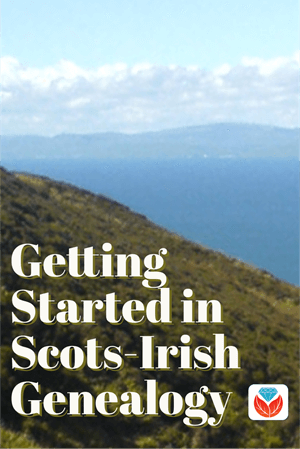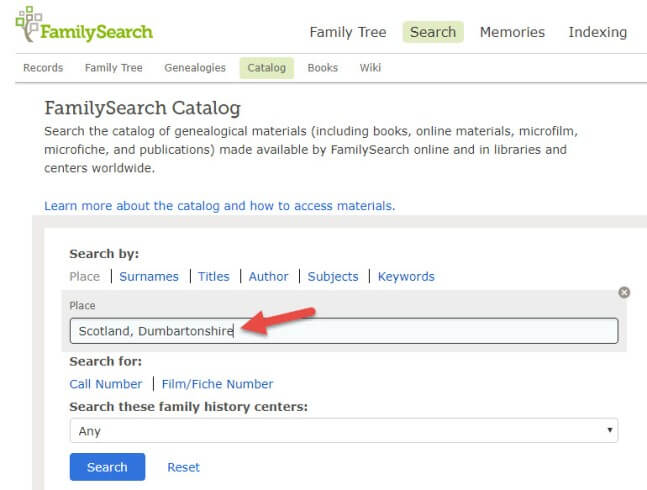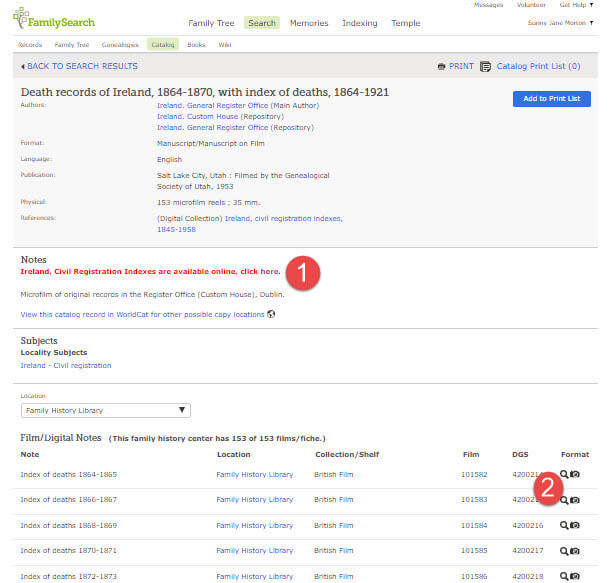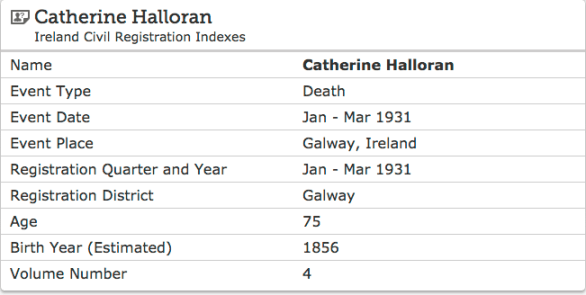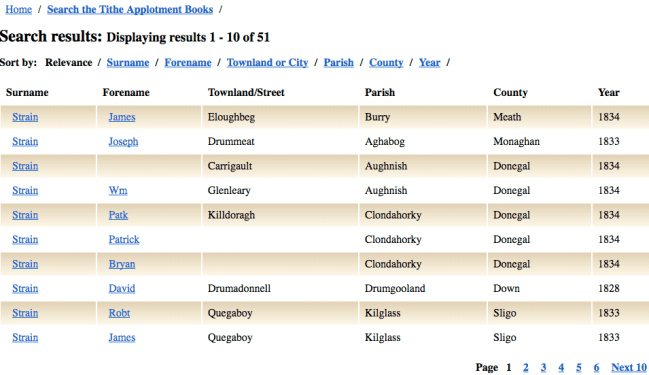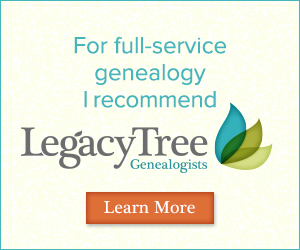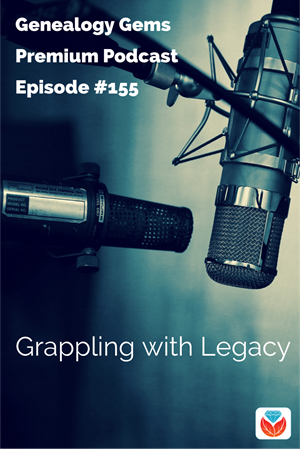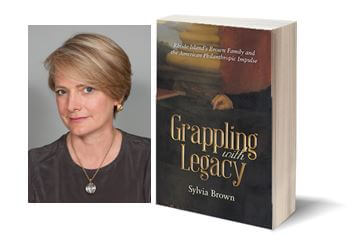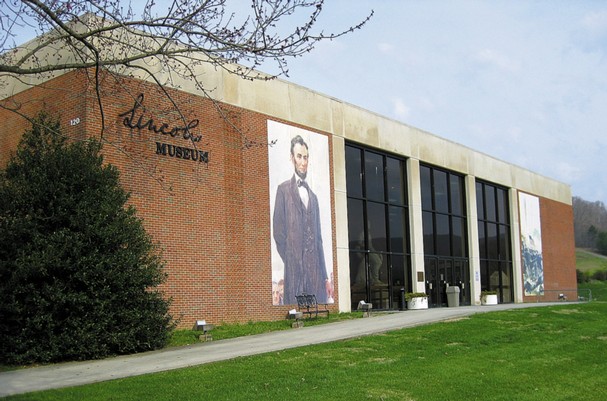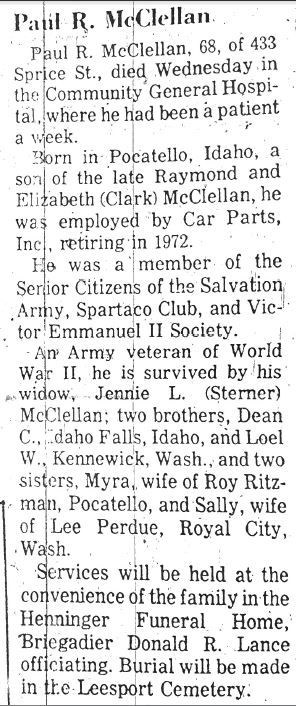Blog

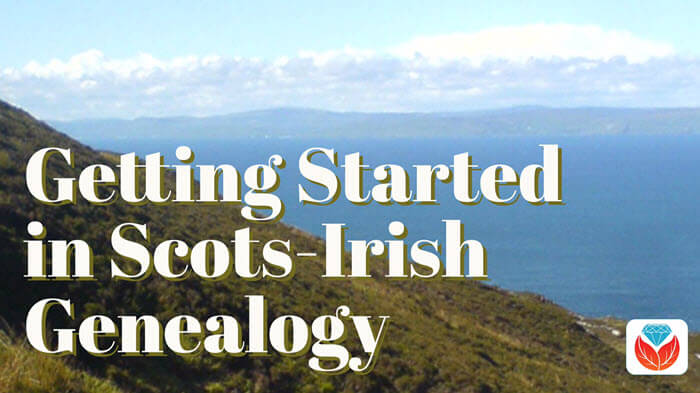
Scots-Irish Genealogy: Getting Started
Researching your Scots-Irish genealogy is easier if you can identify your ancestors as Scots-Irish! The Scots-Irish put down early roots in Virginia, the Carolinas, and the Appalachian “backcountry” and would likely have come from Northern Ireland or Scotland. Read these important tips for tracing your Scots-Irish family history.
Thanks to Suzanne Earnshaw, Project Manager at Legacy Tree Genealogists, for providing this expert how-to article on tracing your Scots-Irish family history.
Who were the Scots-Irish?
Researchers use the term “Scots-Irish” to identify a people who went back and forth between Scotland and Ulster, Ireland. The North Channel, shown on the map below (click on it to see the original image), is also known as the Straits of Moyle. It connects the west coast of Scotland and the Mull of Galloway at the narrowest part the strait. There, the strait spans only 13 miles. This short distance between Northern Ireland ports and the western Scotland ports made trade and commuting quite common between Ireland and Scotland.
Researching your Scots-Irish genealogy
To find a Scots-Irish ancestor, start with what you do know. For example, my ancestors immigrated to America from Scotland in the 1880s. I traced my great-great-grandmother here in the US through US records, until I found a record which stated that she had emigrated from New Kilpatrick, Dunbartonshire, Scotland. Then, I began searching Scotland Census records in 1881 to find out more about my ancestors.
Good research methodology includes finding your ancestors in each record possible to get an accurate picture of their life, and collecting data through which you can learn more about the previous generation. As I moved back in time through the Scottish censuses in 1871, 1861, 1851, and finally 1841, I found that some of these family members family on a record were born in Scotland and others were born in Ireland—my ancestors were Scots-Irish and moved fluidly back and forth between Ireland and Scotland. Based on this fact, I then knew to conduct research in records for both Scotland and Ireland to find additional family records.
Scots-Irish Genealogy Resources on FamilySearch.org
The free genealogy giant FamilySearch.org has a variety of records available, which are cataloged by collection. To learn what collections are available, go to familysearch.org, sign in for free (click here to learn how and why), click Search and then Catalog. Type in the place you would like to search for record collections.
Records were often kept at a variety of government and church levels, and they might be cataloged differently. To properly research, type in “Scotland” and see what records are available. Then type in a narrower geographic area such as “Scotland, Dumbartonshire” and see which of those records might be of interest to you. The next search would be even more specific: “Scotland, Dumbartonshire, New Kilpatrick.” This increasingly-specific record search process can be done for any place.
If you type “Ireland” into the FamilySearch catalog request, one of your choices is the collection Death records of Ireland, 1864-1870, with index of deaths, 1864-1921. Clicking on this collection takes you to the collection page. There is a note: “Ireland, Civil Registration Indexes are available online” (see #1 in the screenshot below). By selecting that option, you will be able to search an index of names that appear in “1864-1958 births, 1845-1958 marriages, and 1864-1958 deaths, but excluding index records for Northern Ireland after its creation in 1922.” Note that the index extends to 1958, further than the collection name indicates.
Searching this index is a good first step, since it will provide you with the registration district if your ancestor is listed. Type in the name and identifying details. When I searched for “Catherine Halloran” Death 1900-1950, I found the birth that matched and it gave me the registration district as Galway.
To view record images available in this collection, you’ll need to scroll down on the above catalog page. You’ll see the collection broken down into groups of records. Those with a camera icon on the far right (#2 above) have digital images on the site that you can browse through page by page. (Click here for instructions on browsing FamilySearch images.) Unfortunately, images of the original 1931 death records and the original index aren’t on the site; you’d only be able to look at original records through 1870 and the original index through 1921, as the collection name indicates.
More sites for tracing Scots-Irish genealogy
Irishgenealogy.ie. This website is free and home to the historic records of Births, Marriages, and Deaths of the General Register Office. Civil registration in Ireland began in 1864. Church records are also available on this website. Most on this website are for the Roman Catholic Church, but they do have some Presbyterian records as well.
The Ulster Irish were mostly Protestant by faith, since many were originally English. The Scots mostly worshiped as Presbyterians (a type of Protestantism). Knowing your ancestor’s religion might be a clue to which records to begin research.
AskAboutIreland.ie. This website can help you research your family pre-census. The Primary Valuation was the first full-scale valuation of property in Ireland. It was overseen by Richard Griffith and published between 1847 and 1864. To find your family, enter their surname in the search box. If you know the county you can put in that as well to limit the amount of records returned. Tip: Searching without the location can give you an understanding of the distribution of a surname at the time the valuation was taken.
Tithe Applotment Survey at NationalArchives.ie. This site has the Tithe Applotment Survey of 1823-1938 for the 26 counties of the Republic.
ScotlandsPeople.gov.uk. For information on how to search Scottish records on this official website for searching government records and archives, click here.
Here is my final tip: as you research your Scots-Irish ancestors be sure to thoroughly search record collections by looking for a variety of spellings, using wildcards in your search terms, and reviewing original records page by page when you don’t find them in indexes.
Legacy Tree Genealogists is a worldwide genealogy research firm with extensive expertise in breaking through genealogy brick walls. To learn more about Legacy Tree services and its research team, visit https://www.legacytree.com. EXCLUSIVE OFFER for Genealogy Gems readers! Receive $100 off a 20-hour+ research project from Legacy Tree Genealogists with code GGP100.
Disclosure: This article contains offers with affiliate links, which may expire without notice. Genealogy Gems will be compensated if you make a purchase after clicking on these links (at no additional cost to you). Thank you for supporting Genealogy Gems!
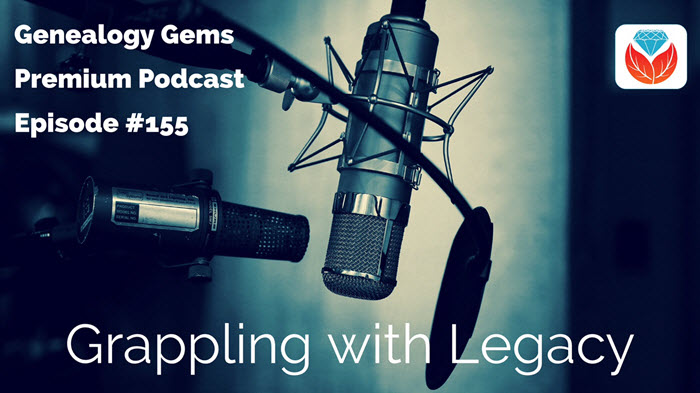
Genealogy Gems Premium Podcast Episode 155: Grappling with a Unique Family Legacy
In the new Genealogy Gems Premium Podcast Episode 155, Lisa Louise Cooke talks with author Sylvia Brown about coming to terms with her renowned New England family’s legacy of wealth, philanthropy–and slaveholding. Also in this episode: Facebook helps a lost WWI gravemarker make its way home, a listener’s question about organizing her Ancestry.com tree, and Melissa Barker talks about genealogical treasures you may find in museums.
Genealogy Gems Premium Podcast Episode 155
In the newest episode of the Genealogy Gems Premium Podcast, Premium members get to hear a fascinating interview with Sylvia Brown, a descendant of the renowned Brown family of Rhode Island that is affiliated with Brown University. Sylvia recently published Grappling with Legacy, a book that’s part family history and part reckoning with it. She decided to explore her family history after hearing a speaker at Brown University–the same Brown University to which Sylvia’s father gave a big part of his inheritance–declare that “there were no good Browns!”
A Kirkus review of this book calls it “an often riveting history of a family that left an indelible impact on the nation.” In Sylvia’s conversation with Lisa, you’ll hear some of the story of that broader impact, but also its narrower impact on Sylvia herself and her living relatives. Her family history is so personal, and yet so public. Hear how she has “grappled with legacy” in this inspiring interview.
Also in Premium Podcast Episode 155
There’s more to inspire and inform your passion for heritage in this episode! For example:
- Lisa tells of a World War I gravemarker for a Michigan man that was found in Florida by a man on a cleanup crew. Hear how he used the power of social media to help the marker find its way back to its family.
- Joyce asks whether it’s possible to rearrange the chronological order of marriages on a person’s Ancestry page once they have been entered. She’s frustrated because they don’t show up that way on the person’s profile. Genealogy Gems Contributing Editor and expert on Ancestry.com and the other “genealogy giants” shares her answer, along with a tip for keeping your Ancestry tree as accurate as possible, even when your best answer may be guess.
- Finally, the Archive Lady Melissa Barker describes genealogical treasures you may find in museums, such as the Lincoln Memorial University Museum shown here. Museums aren’t always “just” galleries of old artifacts–they may also be archives. But you may have to go looking for their documents and manuscripts.
Genealogy Gems Premium membership
Genealogy Gems Premium members have 24/7 access to the entire Genealogy Gems Premium Podcast archive! To date, that means 154 previous episodes. We often hear from listeners who discover us and start listening–then rewind so they can hear everything they’ve missed since the Premium Podcast began production. In addition, Premium members also have access to dozens of full-length video tutorials on a variety of subjects that will help you harness tech tools, research more effectively, organize your family history and share it with loved ones. Check out this preview of the newest Premium video: “Time Travel Technology.” And if you’re not already one, consider becoming a Genealogy Gems Premium subscriber today!
Disclosure: This article contains affiliate links and Genealogy Gems will be compensated if you make a purchase after clicking on these links (at no additional cost to you). Thank you for supporting Genealogy Gems!

About the Author: Sunny Morton
Sunny is a Contributing Editor at Lisa Louise Cooke’s Genealogy Gems; her voice is often heard on the Genealogy Gems Podcast and Premium Podcast. She’s known for her expertise on the world’s biggest family history websites (she’s the author of Genealogy Giants: Comparing the 4 Major Websites); writing personal and family histories (she also wrote Story of My Life: A Workbook for Preserving Your Legacy); and sharing her favorite reads for the Genealogy Gems Book Club.
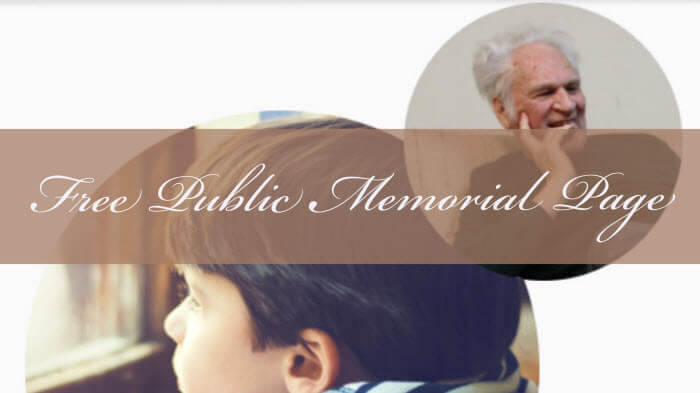
Creating Free Online Memorials for Deceased Relatives: A New Option from Ancestry.com
Creating free online memorials for your deceased relatives and ancestors is a wonderful way to remember and honor them. Genealogy giant Ancestry.com has created a new portal for posting these free online obituaries. Here’s what Ancestry.com’s “We Remember” tool is all about, and how you can use it.
A need for free, lasting online memorials
For several years, I have been concerned that newspaper obituaries are quietly going away, along with the popularity of print newspapers themselves. Obituaries and death notices fill important purposes. They help a family and community say goodbye. They pay tribute to loved ones and to lives well-lived (or ended too soon). They quietly but effectively spread news of a death, removing some of that burden from a grieving family. And for years to come, newspaper obituaries help genealogists learn their family history.
Increasingly, we share news of a loved one’s passing directly via social media channels–sometimes instead of in newspapers. These social media messages are personal and powerful, often accompanied by images or video and supplemented with others’ comments. But they don’t entirely replace the obituary:
- They only reach those within our social media reach.
- They often don’t contain the same rich genealogical information an obituary may mention.
- Some may not easily be searchable by those who want to find them.
As younger generations age into the role of decision-makers after a loved one passes, they will decide on behalf of a family how and where a loved one is formally memorialized. Print obituaries may not seem important or relevant to those who don’t rely so heavily on newspapers.
Online memorials posted by funeral homes and sites such as Legacy.com have somewhat filled this gap. They have brought obituaries into dedicated online spaces where loved ones can share biographical information, photos and memories. However, many online memorials are only published temporarily. Many require a fee either to create or to maintain—or both.
A new option for free online memorials
That’s why I’m pleased to see that Ancestry.com has launched We Remember, a free online space for posting and sharing public memorials for deceased loved ones and ancestors. According to the press release, “Rather than being a research page, the ‘We Remember’ page is designed to gather and showcase memories about your loved one. You can celebrate their life by bringing together those who knew them and collecting stories, and photos, to paint a rich picture of who they were.”
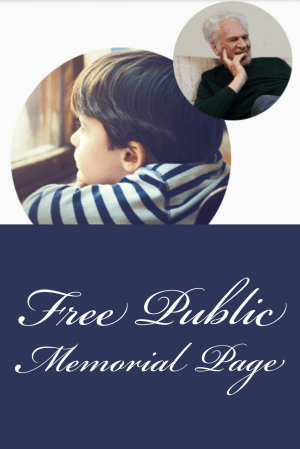
A ‘We Remember’ memorial has 3 parts:
- Tribute: Shows their name, photo, and a headline about them and/or their obituary
- Guestbook: Lists all who have signed the page and how they are connected to the deceased (family, friends, coworkers, schoolmates).
- Memories: Shows memories people have added. So far, this photos and stories; Ancestry.com hopes to add audio and video options in the future.
The web-based platform doesn’t require an app and can be used from your computer, tablet or smart phone. The memorials are interactive and “intended for sharing and collaborating, gathering everyone’s memories together. There are multiple options for sharing on the site: email, Facebook, or just copying the link and sharing it directly with friends and family.” You can post questions for those who visit to answer.
Essentially, ‘We Remember’ brings the death notice announcement out of your everyday social media environment and creates a stand-alone place for anyone who is online to visit.
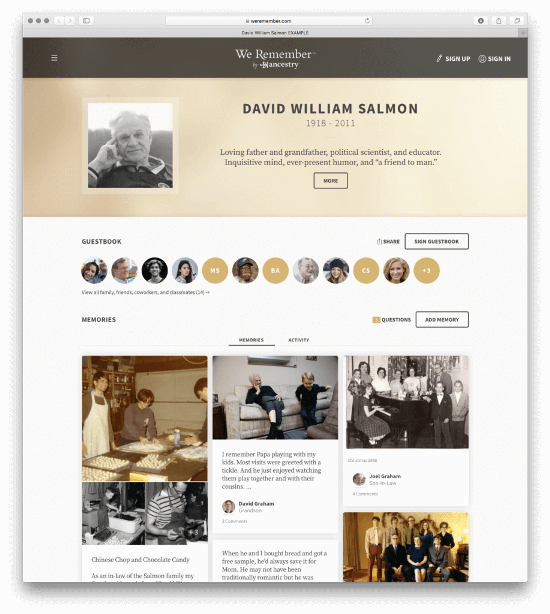
Questions about ‘We Remember’
Of course, questions immediately arise about how permanent and free this service will remain, and whether it will become searchable so others may discover their family history on it. Here at Genealogy Gems, we always advise not relying on any single online or offline ‘container’ for your memories, photos and other family history treasures. Genealogy technology expert Lisa Louise Cooke always advises sharing online in selected places, but keeping master files of everything offline and backed up.
Ancestry.com responded to these and other concerns about ‘We Remember’ with comments I want to share here:
- Will it stay free? “We have created [We Remember] as a free product to capture and preserve memories. (If that ever changed – which we don’t expect at this point – any pages created before a change would stay free.)”
- Can we save what people post to our own master files offline? “We also hope to create features in the future to allow you to save content from a We Remember memorial page to your computer, such as in a file that you could view or print.”
- Can we link memorial pages to profiles on our Ancestry.com trees? “We haven’t built any features around that yet but have received suggestions to link between We Remember pages and profile pages of ancestors in your tree and that is something we’re actively looking at and considering.”
- Will we be able to search We Remember memorial pages? “That is something that we have planned but haven’t built yet.”
- Is it going to remain ad-free? “We Remember purposefully does not have ads on it, and we have no plans to include ads in the future.”
- What about other questions concerning privacy and managing the memorial? The site has a frequently asked questions page that addresses whether you need an account, how to limit access and manage content posted by others and more.
Clearly, ‘We Remember’ is still a work-in-progress by genealogy giant Ancestry.com. But the portal is free, easy to use and beautifully-formatted. Check it out for yourself and consider using it as one way to share the news of a loved one’s death. If you do decide to use it, don’t forget to save a copy offline of the memories and photos posted by others: screenshot them if necessary!
Create a video memorial of a loved one
One of Lisa Louise Cooke’s many inspiring talents is creating short, powerful family history videos that help her celebrate the people and memories that matter most. She does a fabulous job of teaching step-by-step how we can do the same! Click here to follow her instructions on how to create a short video to spotlight a loved one.

Sunny Morton
Sunny Morton is a Contributing Editor at Lisa Louise Cooke’s Genealogy Gems; her voice is often heard on the Genealogy Gems Podcast and Genealogy Gems Premium Podcast. She’s especially known for her expertise on the world’s biggest family history websites (she’s the author of Genealogy Giants: Comparing the 4 Major Websites); writing personal and family histories (she also wrote Story of My Life: A Workbook for Preserving Your Legacy); and sharing her latest favorite reads for the Genealogy Gems Book Club. Sunny is also a Contributing Editor at Family Tree Magazine and the NGS-award-winning Co-Editor of Ohio Genealogy News.
Disclosure: This article contains affiliate links and Genealogy Gems will be compensated if you make a purchase after clicking on these links (at no additional cost to you). Thank you for supporting Genealogy Gems!
